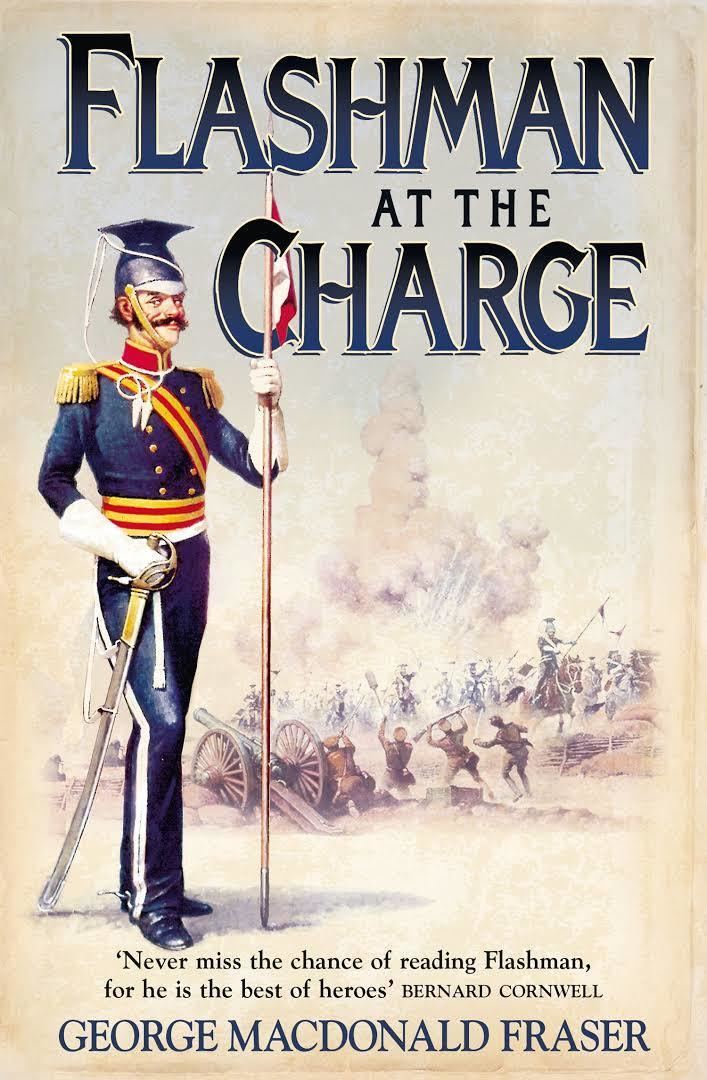8.8 /10 1 Votes8.8
Language English Publication date 1973 Page count 286 | 4.4/5 Goodreads Country United Kingdom Publisher Barrie & Jenkins Originally published 1973 Preceded by Flash for Freedom! Genre Historical drama | |||||||||||||||||||||||||||||||||
 | ||||||||||||||||||||||||||||||||||
Similar George MacDonald Fraser books, Flashman Papers Series books, Fiction books | ||||||||||||||||||||||||||||||||||
Flashman at the Charge is a 1973 novel by George MacDonald Fraser. It is the fourth of the Flashman novels. Playboy magazine serialised Flashman at the Charge in 1973 in their April, May and June issues. The serialisation is unabridged, including most of the notes and appendixes and features a few interesting illustrations, collages from various paintings and pictures to depict a period montage of the Charge and Crimea.
Contents
While George MacDonald Fraser claimed he never had a favourite among the Flashman novels he said his agent, George Greenfield, thought this was the best.
Plot introduction
Presented within the frame of the supposedly discovered historical Flashman Papers, this book describes the bully Flashman from Tom Brown's School Days. The papers are attributed to Flashman, who is not only the bully featured in Thomas Hughes' novel, but also a well-known Victorian military hero. The book begins with an explanatory note detailing the discovery of these papers.
Flashman at the Charge begins with Flashman trying to avoid a transfer to the Crimea but failing miserably. He is made guardian of one of Queen Victoria's cousins and is sent to the midst of the Crimean War. Flashman witnesses and participates in the most notable offensive and defensive actions of that war, and eventually finds himself trekking across Asia in an effort to save the British Raj. Flashman at the Charge covers the years 1854 to 1855. It also contains a number of notes by Fraser, in the guise of editor, giving additional historical information on the events described.
Plot summary
Flashman meets Queen Victoria's cousin, William of Celle, incognito in a billiards hall and, without knowing his true identity, befriends him, before getting him drunk and leaving him in an alley with Shoe polish covering his buttocks for the police to find. However, his reputation as a valiant and down-to-earth soldier leads to Prince Albert assigning Flashman as the boy's mentor. Despite every attempt to avoid it, he finds himself in the Crimea showing William what soldiering is all about. The boy's unfortunate death does not allow Flashman to avoid involvement in the most notable actions of the Crimean War, including The Thin Red Line, the Charge of the Heavy Brigade under James Yorke Scarlett, and the infamous Charge of the Light Brigade.
Powered by fear and flatulence, he reaches the Russian guns in front of the other surviving members of the charge and promptly surrenders. He is taken into Russia (now Ukraine) and placed in the custody of Count Pencherjevsky. Here he reunites with Scud East, his old schoolmate, and meets Nicholas Pavlovich Ignatiev, a vicious Russian Captain.
Flashman and East overhear plans by senior Russian officers to invade India and end the British Raj. The two men escape from the Count's estate (thanks to a peasant uprising), but Flashman is recaptured by the Russians. Ignatiev takes Flashman with him across central Asia as part of his plans to conquer India. Flashman is rescued from prison by cohorts of Yakub Beg, led by his Chinese paramour. Then the Tajik and Uzbek warriors attack the Russian fleet using Congreve rockets captured from the Russians, which only Flashman knows how to use. Prior to the battle, Flashman was unknowingly drugged with hashish and is utterly fearless as a result, for the only time in his life. The Russian ships are destroyed and Flashman then travels on to British India.
